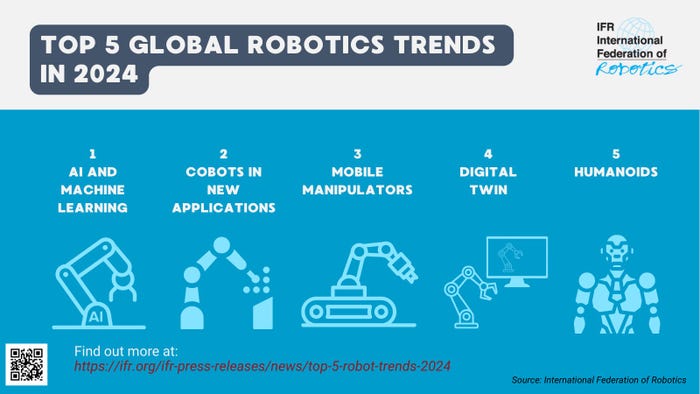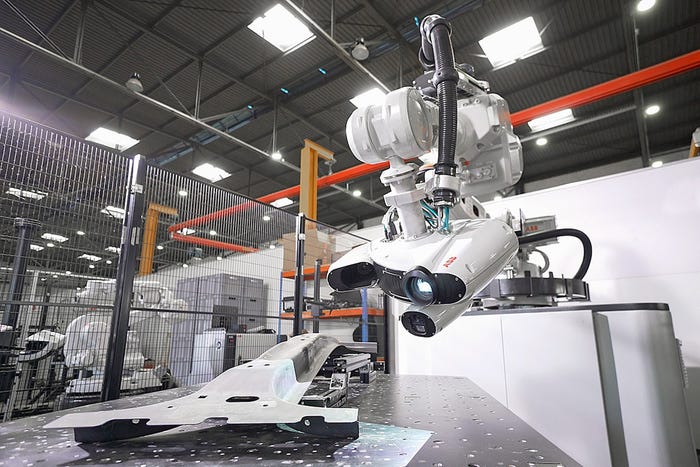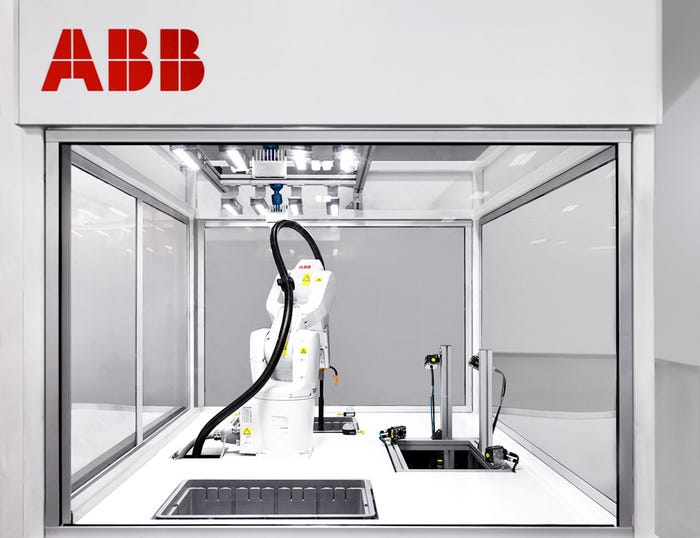Top Trends in Robotics for 2024
Two robotics organizations lay out the developments in robotics that we can expect through the coming year.
March 27, 2024

At a Glance
- Robotics takes on artificial intelligence
- How digital twins are enabling robots
- Check out the advances in humanoid robots
The number of operational robots around the globe hit a new record in 2023, reaching 3.9 million units, according to the International Federation of Robotics. The demand is driven by a wide range of technological innovations that have made robots more effective and easier to operate. Advances include AI, improvements in mobile robot mapping, and configuration tools that reduce or eliminate the need for original programming. Two robotics industry organizations have detailed the trends we can expect to see in technology developments this year.
The International Federation of Robotics (IFR) came out with the report, Top 5 Robot Trends in 2024, and A3 (the Association to Advance Automation) published a report from ABB identifies new frontiers for robotics and AI for 2024.
Here are the top five robot trends identified by the International Federation of Robotics:

Image courtesy of the International Federation of Robotics.
1. Artificial Intelligence (AI) and Machine Learning
IFR pointed out that the trend of using Artificial Intelligence in robotics and automation keeps growing. The emergence of generative AI opens up new solutions. This subset of AI is specialized in creating something new from things it’s learned via training and has been popularized by tools such as ChatGPT. Robot manufacturers are developing generative AI-driven interfaces which allow users to program robots more intuitively by using natural language instead of code. Workers will no longer need specialized programming skills to select and adjust the robot´s actions.
IMR noted that another example is predictive AI analyzing robot performance data to identify the future state of equipment. Predictive maintenance can save manufacturers machine downtime costs. In the automotive parts industry, each hour of unplanned downtime is estimated to cost $1.3m – the Information Technology & Innovation Foundation reports. This indicates the massive cost-saving potential of predictive maintenance. Machine learning algorithms can also analyze data from multiple robots performing the same process for optimization. In general, the more data a machine learning algorithm is given, the better it performs.
2. Cobots Expanding to New Applications
IMR explained that human-robot collaboration continues to be a major trend in robotics. Rapid advances in sensors, vision technologies and smart grippers allow robots to respond in real-time to changes in their environment and thus work safely alongside human workers.
Collaborative robot applications offer a new tool for human workers, relieving and supporting them. They can assist with tasks that require heavy lifting, repetitive motions, or work in dangerous environments.
The range of collaborative applications offered by robot manufacturers continues to expand.
IMR pointed out that one recent market development is the increase of cobot welding applications, driven by a shortage of skilled welders. This demand shows that automation is not causing a labor shortage but rather offers a means to solve it. Collaborative robots will therefore complement – not replace – investments in traditional industrial robots which operate at much faster speeds and will therefore remain important for improving productivity in response to tight product margins.
New competitors are also entering the market with a specific focus on collaborative robots. Mobile manipulators, the combination of collaborative robot arms and mobile robots (AMRs), offer new use cases that could expand the demand for collaborative robots substantially.
3. Mobile Manipulators
For the third trend, IFR noted that mobile manipulators – so called “MoMas” – are automating material handling tasks in industries such as automotive, logistics or aerospace. They combine the mobility of robotic platforms with the dexterity of manipulator arms. This enables them to navigate complex environments and manipulate objects, which is crucial for applications in manufacturing. Equipped with sensors and cameras, these robots perform inspections and carry out maintenance tasks on machinery and equipment. One of the significant advantages of mobile manipulators is their ability to collaborate and support human workers. Shortage of skilled labor and a lack of staff applying for factory jobs is likely to increase demand.
4. Digital Twins
IFR pointed out that digital twin technology is increasingly used as a tool to optimize the performance of a physical system by creating a virtual replica. Since robots are more and more digitally integrated in factories, digital twins can use their real-world operational data to run simulations and predict likely outcomes. Because the twin exists purely as a computer model, it can be stress-tested and modified with no safety implications while saving costs. All experimentation can be checked before the physical world itself is touched. Digital twins bridge the gap between digital and physical worlds.
5. Humanoid Robots
IMR sees major advances in humanoid robotics. We're seeing significant advancements in humanoids, designed to perform a wide range of tasks in various environments. The human-like design with two arms and two legs allows the robot to be used flexibly in work environments that were actually created for humans. It can therefore be easily integrated e.g. into existing warehouse processes and infrastructure.
The Chinese Ministry of Industry and Information Technology (MIIT) recently published detailed goals for the country’s ambitions to mass-produce humanoids by 2025. The MIIT predicts humanoids are likely to become another disruptive technology, similar to computers or smartphones, that could transform the way we produce goods, and the way humans live.
The potential impact of humanoids on various sectors makes them an exciting area of development, but their mass market adoption remains a complex challenge. Costs are a key factor and success will depend on their return on investment competing with well-established robot solutions like mobile manipulators, for example.
ABB Identifies New Frontiers for Robotics and AI in 2024

Manufacturing robot. Image courtesy of ABB.
In an article presented by A3 (the Association to Advance Automation), robot producer ABB identified three drivers for robotics-driven AI solutions in 2024.
Marc Segura, president of ABB’s Robotics Division spelled out these developments as ABB continues expansion in new segments not previously served by robotic automation. “The coming year will see a growing focus on the critical role of AI,” said Segura in a statement. “From mobile robots and cobots, to enabling new robotic applications in new sectors and creating new opportunities for people to learn and develop, these new frontiers for AI are redefining the future of industrial robotics.”
Here are the three drivers in 2024 according to ABB:
1. AI Will Drive New Levels of Autonomy in Robotic Applications
ABB noted that accelerating progress in AI is redefining what is possible with industrial robotics. AI is enhancing everything from robots’ ability to grip, pick and place as well as their ability to map and navigate through dynamic environments. From mobile robots to cobots and beyond, AI is giving robots unprecedented levels of speed, accuracy, and payload carrying ability, enabling them to take on more tasks in settings like flexible factories, warehouses, logistics centers and laboratories.

ABB robot picker. Image courtesy of ABB.
2. AI Will See Robots Enter New Sectors
ABB noted that the potential of AI-enabled robotics is influencing sectors far beyond manufacturing. In 2024, these technologies are expected to bring substantial efficiency improvements to more dynamic environments, such as healthcare and life sciences, as well as retail. Another example is the construction industry, where AI-powered robotics can make a material contribution to boosting productivity, enhancing safety and sustainable construction practices while spurring growth.
3. AI Will Offer New Opportunities for Education and Working with Robots
ABB explained that the advances in AI and robotics are significant for training and education, closing the automation skills gap and making robots more accessible to more people and businesses. With AI making programming easier, through lead-through and even natural language, education can shift more towards how robots can assist humans more effectively, rather than just teaching programming skills. This transition will make robots more approachable and bring them to a wider audience, leading to new job prospects while helping alleviate labor and skills shortages.
About the Author(s)
You May Also Like





